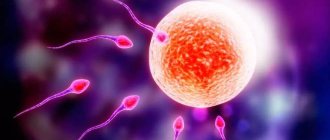Features of chromosomal organization
Heredity is the result of a combination of genes, the ability to copy similar characteristics from generation to generation. Thanks to this ability, people from the same clan have similar appearance features, metabolism, and physique.
Heredity is determined by chromosomes - nucleoprotein formations containing genes. It is in the chromosomes that all hereditary information is contained.
In the human body, each somatic cell includes 23 pairs of chromosomes (46 in total), each of which contains genetic information. This set of chromosomes is called diploid (paired).
22 pairs are identical in both men and women. They are called autosomes because they do not depend on the sex of the person.
Those chromosomes that are responsible for gender identification are called sex chromosomes - the 23rd pair. They are designated by the letters Y or X. Two identical X chromosomes indicate the female gender, a combination of the X and Y chromosomes indicates the male gender.
The cellular organization of the female body includes 46 identical X chromosomes, and the male body - 46 different sex chromosomes.
Haploid (single) chromosome set - 23 chromosomes, which are contained in eggs and sperm. Their function is to participate in the formation of cells after seminal fluid enters the egg.
What determines the sex of the unborn child?
To find out which parent determines the sex of the child, you need to understand which chromosomes the sex cells carry. The egg cell includes a permanent component - the X chromosome, in contrast to it, the sperm can include both the X and Y chromosomes.
If at the moment of conception a sperm with an X chromosome penetrates into the egg, the gender of the unborn child will be female, if a sperm with a Y chromosome, a boy will be born.
It is impossible to find out the gender of the child in advance, as it depends only on the sperm that fertilizes the egg. It turns out that the man is dominant in gender identification. When planning the gender of your child, this is the only thing you can be sure of.
It has been established that a man who has many brothers is more likely to have sons, and vice versa. Only a minority of males have seminal fluid that contains approximately equal numbers of Y and X chromosomes, meaning they are equally likely to be born a girl or a boy.
Hormones influence behavior.
By understanding androgen resistance syndrome, scientists are beginning to understand how powerful hormones influence our development. What about mental development? Does the influence of hormones affect differences in male and female behavior?
If we observe what children play with, then, as a rule, we will see that girls play with dolls more often than boys, and boys play with cars, trains, and the like. For 40 years now, we have known that testosterone and other hormones have powerful effects on animal behavior. However, in relation to humans, the question remained open for a long time due to the extreme difficulty of conducting pure experiments. It's clear that we can't just inject hormones into people to see what happens.
We are not researchers, but we can easily detect differences in male and female behavior. It is not so easy to isolate the influence of many factors influencing male and female development. But recently interesting facts have emerged indicating that hormones play a significant role in this.
Myths about the possibility of planning the gender of your baby
Some women believe that the birth of a boy or girl is influenced by diet before sexual intercourse, duration of sleep, or frequency of sexual contacts before fertilization.
They want to know what exactly determines the sex of the child at conception.
The most common anti-scientific ideas about calculating the sex of a baby include:
- Renewal of blood in men and women. It is believed that human blood is regularly renewed over a certain period of time. The gender of the baby will be identical to the gender of the parent with renewed blood. Blood quality does not affect the process of conception.
- “Reprogramming” the female body . According to this theory, a woman “switches” to having children of the opposite sex every 3 years. That is, the birth of a boy or girl can simply be calculated by waiting a few years. The sex of the child depends only on the biological material of the father.
- The power of germ cells. It is argued that during specific life cycles, eggs and sperm become “more energetic” or “weaker,” which determines the conception of a boy or girl. The egg does not affect the fertilization process in any way. What is important is the activity and persistence of the sperm.
- Special food. Some believe that a couple's diet before conception can influence the sex of the child. Including certain nutritional elements in the diet can only improve the quality of the spouse’s sperm, and accordingly, increase the chance of getting pregnant.
- Japanese, oriental, Chinese calendars that help calculate the gender of the baby. These tables are not based on scientific data, they do not take into account the cyclicity of menstruation and other reproductive features.
Some even believe that the zodiac sign of the parents can influence the gender identification of the unborn child. Such theories have no scientific basis and should not be taken seriously.
Is it possible to choose the gender of the child?
Sperm are responsible for the sex of the child. They contain the X (girl) or Y (boy) program. The female egg has only the X-program. Consequently, the sex of the unborn child depends on the man.
“Strictly speaking, the only more or less scientific method of conceiving a child of the desired gender depends on ovulation,” says gynecologist Alexander ZAKHAROV. — The point is that the more nimble and nimble, but less hardy “male” Y-spermatozoa can reach the egg faster than “female” ones. But “female” ones, on the contrary, are imposing and unhurried, but much more resilient. Therefore, they can wait for ovulation and fertilize the egg, while the “male” ones may already die by this time.
Method number 1 - temporary
On average, an egg remains fertile for 36 hours. Based on this, you can try to “calculate” the sex of the unborn child. Let's take the standard 14th day from the start of menstruation.
So, if you want a boy:
Try to abstain from sex for three to four days before conception. This will increase sperm concentration and motility.
Conception must directly occur during ovulation. That is, strictly on the 14th day. Or at most the day before.
The pose is “doggy style”. The deeper the penetration during conception, the easier it is for sperm to reach their destination. They live in the alkaline environment of the uterus for 24 hours.
If you want a girl:
Have sex 2 - 3 days before ovulation. More - no, no. Patient and tenacious “female” sperm will wait their time and fertilize the egg.
The pose is “missionary”. With shallow penetration, sperm remain in the vagina. The less tenacious “male” ones quickly die in an acidic environment, while the female ones slowly move towards the fallopian tube.
Method number 2 - quantitative
British doctors say: the longer it takes to get pregnant, the more likely it is that a boy will be born. They made such conclusions after collecting information about 5,000 women in labor. 58 percent of women who took more than 12 months to conceive gave birth to boys. Each subsequent year spent trying to conceive a child increases the likelihood of having a boy by another 4 percent.
Russian sex therapist Yuri Zharkov claims that the more attracted couples are to each other, the more often they have sex, the greater the likelihood of having a boy. If the rhythm of sexual life is lame, passion fades away, then it is more likely to conceive a girl.
Method number 3 - nutritious
The French, in their studies of the influence of food on expectant mothers, discovered an interesting pattern. The more calcium in the expectant mother’s food, the higher the likelihood that a girl will be born. And the lower the calcium, the more likely it is to conceive a boy.
Nutrition for conceiving a girl:
coffee, tea, chocolate, mineral waters with calcium;
meat - any fresh, but not sausages or ham;
fish - only freshly prepared, not canned, smoked, dried;
milk and cottage cheese, but not cheese;
all vegetables, except potatoes, cabbage of all types, raw tomatoes;
fruits - apples, pears, strawberries, peaches, pineapples, etc. (except plums, bananas, oranges, currants, melons).
Limit salt and, in general, everything smoked, pickled and canned.
To conceive a boy:
tea, coffee, beer, fruit juices (except milk);
meat - any, including sausage, ham, corned beef, boiled pork and other delights of the sausage industry;
fish - any (except shrimp and crabs);
more potatoes, mushrooms, beans (except green salad, raw cabbage, dill);
fruits - all, especially bananas, dates, apricots, oranges;
there should be more salt. As well as canned food, spices, smoked meats.
Limit bread, pancakes, waffles and other products containing milk.
COMMENT BY A NUTRITIONIST
“This technique is very controversial,” says nutritionist Evgenia LESKOVETS. — I heard about another set of products, and also research was confirmed by certain numbers. Of course, such a diet will not harm your health in principle. But provided that it is observed no more than two to three months before conception. After conception, it will no longer be of any use. It can be assumed that eating slightly or highly salted foods may change the chemical composition of the vagina, thereby promoting the survival of a certain type of sperm. But this has not been scientifically proven.
Method number 4 - folk
From popular belief. If you get pregnant in November - January, you are more likely to have a boy. If from May to July - a girl.
Most mothers in their intimate confessions say that if during conception they experienced orgasm, pleasure, trust in their partner, then a girl was born. If these feelings were reduced, as was pleasure, then it’s a boy.
Method number 5 - ECO-logical
Almost 100% success awaits parents of test tube children. If there is a serious disease in the family that is inherited only by boys or only by girls, then with in vitro fertilization you can choose the gender of the unborn child. But experts do not recommend going for IVF just for the desired sex of the child.
“When the egg has already been fertilized and the embryo has begun to form, you can take one cell from it and see whether it is a boy or a girl,” says Alexander Zakharov. “But this method is not only expensive, but most importantly, it is not safe for a woman’s health.
HELP "KP"
Determining ovulation
The main, but not the most accurate method is the calendar method. Effective only with a regular cycle. With a 28-day period, for example, ovulation will occur on the 14th day from the start of the previous menstruation.
The temperature method is the cheapest. Measuring morning temperature in the anus. An increase of 0.2 degrees in the middle of the cycle usually indicates ovulation. But it’s also not accurate.
Hormonal method. Special test strips determine the level in the urine of a certain hormone responsible for ovulation (five strips - from 300 rubles).
Ultrasound monitoring. Expensive and time-consuming, but the most reliable. Regular ultrasound examination in the middle of the cycle will tell you when ovulation will occur (one session - from 400 rubles, three to five ultrasounds will be required).
x HTML code
Is it possible to choose the gender of the child? There are many different predictions on how to conceive a boy or girl. But do they give a 100% guarantee? [video]
Scientific methods for calculating the sex of an embryo
If you still want to give birth to a boy or a girl, then you can resort to new trends in artificial insemination. These methods make it possible to determine the sex of the embryo before it is implanted into the uterus.
Unique methods that guarantee the birth of a baby of the desired gender include:
- R. Erickson's technique. It is based on the separation of sperm into fractions with certain chromosomes. The man must collect biological material that is exposed to an albumin-based product. Cells with Y chromosomes overcome the protein film faster and then settle to the bottom of the tube. The specialist takes the required fractions and introduces them to the woman artificially.
- Laser sperm selection. Germ cells are separated using laser irradiation. The required part of the seminal fluid remaining after sifting is injected into the uterus or fertilization is carried out in vitro.
- Preimplantation technology. When embryos obtained artificially are diagnosed for the presence of developmental abnormalities and their gender is revealed. A material that combines the necessary chromosomes is implanted into the uterus.
Further improvement of methods for determining the sex of an embryo and the choice of a similar method of conception is complicated by ethical factors.
What is passed on to the baby from the mother, and what from the father?
The gender of the child depends only on the man.
But many of the baby’s distinctive features depend on both maternal and paternal genes. Let's find out which genes predominate and in which cases.
Appearance
Y chromosomes are endowed with a significantly smaller number of genes, most of which are involved in the production of sperm and the formation of genital organs.
This explains the fact that boys are more like their mothers. And girls receive X chromosomes from both parents, so their appearance is difficult to predict.
Intelligence
The genes that are responsible for the child's intellectual abilities are located on the X chromosome.
Therefore, only mothers are responsible for the mental abilities of their sons. Daughters inherit the mental abilities of both parents.
Completeness
The tendency to be overweight is also due to genetic predisposition. It is transmitted equally from both parents.
It is noteworthy that fatness dominates over thinness. But the weight of a newborn at birth depends only on the mother.
Height
Both mothers and fathers influence the baby's body length. Children of tall men are born with heights above average.
An interesting fact is that in large families, younger children, as a rule, are shorter than older brothers and sisters.
Eye color
Brown eye color dominates all other colors. Therefore, if one of the parents (especially dad) is brown-eyed and the other is not, then the baby will probably have brown eyes.
A brown-eyed child can even appear from blue-eyed parents, and vice versa, which seems incredible. This is explained simply: one of the adults has a recessive gene responsible for a different eye color.
A recessive gene is that genetic information that is suppressed under the influence of a dominant gene. A recessive gene can manifest itself provided that it is located next to the same gene.
Gender planning by cycle days and age of the expectant mother
There is a method by the Polish doctor Benedo, which involves calculating a favorable day for conceiving a son or daughter. So, a boy can be conceived 11-12 days before the start of menstruation, and a girl 13-14 days before this date. Sexual intercourse should be planned depending on these dates. Today there is also a technique that came to us from ancient China.
This is the dependence of the sex of the unborn baby on the age of the expectant mother. According to the method, the even or odd number of a woman’s years and the month of conception are taken into account. So, for example, in an even-numbered year of the expectant mother’s life, you can conceive a girl in February and April, June and August, and October. If the year of a woman’s life is odd, then the girl is conceived in January and March, May and July, September and November.
This method has a clear limitation: it is only suitable for women with regular cycles whose ovulation coincides with the middle of the calendar month. The effectiveness of this method is low.
Another option is to count lunar days. So, for example, in Europe there is an opinion that the gender of the unborn baby is influenced by the zodiac sign in which the Moon is located during the period of conception. Accordingly, the masculine signs are Aries and Gemini, Leo and Libra, Sagittarius and Aquarius. And female signs are Scorpio and Cancer, Pisces and Taurus, Capricorn and Virgo.











